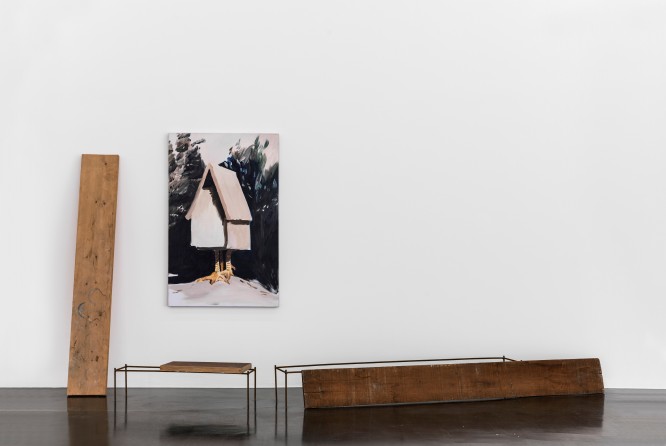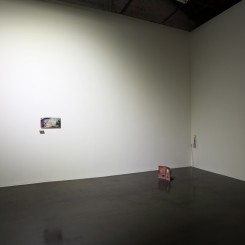Rauschenberg Said, “The Walking Stick Is Longer than the Maulstick, After All.” — Qiu Xiaofei Solo Exhibition
Beijing Commune (798 Art District 4 Jiuxianqiao Road Chaoyang District Beijing 100015), Sep 25 — Nov 11, 2013
Some argue that painting, more than other art forms, requires one to come into its remit. This is not least to do with its conventional presentation which entails a frontal, eye-level relationship with the viewer. Arguably, painting has been the subject of discussion in this sense more prominently than other mediums. Clement Greenberg was most famously preoccupied with its formalism as a force in resistance to the stupefying effect of consumerism on culture. Robert Rauschenberg is credited with a shift in attitude and reception which allowed pop art and the postmodern vein to develop. Under Rauschenberg, the mundane, tangible detritus of daily life and urban culture found its way onto canvas, literally mixed in with the paint. His hybrid painting/sculptures (he called them “Combines”) of the 1950s, particularly, chased off the sectarian visions of Greenberg’s pet-prophets — including Rothko and Newman — with the stuff seen and handled by ordinary people on the street and at home. One could say he made painting more approachable, rather than its audience having to grasp some higher spiritual and aesthetic level. “So, you’re happy to let people make them up as they go along?” the critic Robert Hughes once asked Rauschenberg about his combines; “I insist on that” came the reply.
In the press release for this recent exhibition, Qiu Xiaofei is quoted as saying “If painting is an object coated in color, then all colored objects can be called paintings”; it is something Rauschenberg, or his Combines, might have remarked. The show invoked the older artist heavily, with canvases accompanied by real objects nearby such as a bar of soap, wooden benches, a sculpted pair of feet and a walking stick. The feel of the show was highly considered — certainly an exercise by an inquiring artistic mind — whilst at the same time fitting in with the sensation one has come to expect at Beijing Commune of younger artists aware of a need to prove their capacity for experimentation with each successive solo showing. The title, “Rauschenberg Said, “The Walking Stick Is Longer than the Maulstick, After All.,” positions the name of the earlier artist, a staple of art history, like a platform under Qiu’s pieces.

Qiu Xiaofei, “Chicken Wood”, oil on canvas, wood, steel, 161 x 330 x 80 cm, 2013
仇晓飞,《鸡木》,布面油画,木板,钢,161 x 330 x 80 cm,2013
To date, there can be little doubt of Qiu Xiaofei’s strength as a painter. Such works as “Utopia” (2010) marry medium with message affectively — in this painting, the artist projects a scene of post-ideology through an imagined landscape of tower blocks and a headless statue with arm raised . His small-scale paintings taken from the leaves of family albums articulate the path of personal memory. A sense of isolated, perhaps artificial nostalgia or a phantom quality hovers round domestic appliances and visages; the brushstrokes which comprise the backgrounds (insecure but skilled), evoke physical impermanence but perhaps also the unshakable nature of certain emotions. Qiu’s introverted, examining stance has been discussed in terms of the socio-economic shifts and departures his generation has experienced in China — a very particular context which is different from that surrounding Rauschenberg’s emergence as an artist. Now, however, Qiu seems no longer to be so productively unsettled in himself, or “inconsolable,” as one critic put it. A subjective lens is employed less — probing the nature of perception and aesthetics has moved to the fore. In more recent exhibitions, Qiu has tended to invoke the relationship between painting and objects or props, as in this last show at Beijing Commune, for his concepts (though one remembers here that comment that all colored things might be called “paintings”).
Why talk about a painterly remit in relation to this exhibition? Qiu Xiaofei’s use of objects and installation of and around his paintings means that one cannot, in the same way, become immersed in the content of the canvas alone — there is now more related to it which spills out or sits in the mutual environment of viewer and work, forcibly bridging it, and which one is intended to experience and question. This is a different remit from that of a painting by itself, and in the recent exhibition, the impulsion to enter it was strong. Not least, there was a reverent black bench positioned in front of the focal painting (by Robert Rauschenberg, in fact borrowed for the occasion from Pace gallery New York) with its attendant walking stick and silver balls in a net bag. Before reaching this in the second room, the first thing one encountered was a large setup of a painting of a golden Venus, seen from behind, flanked by tall stands supporting single red, yellow and green strip lights. To put it more simply than the exhibition text, the idea was for the viewer to feel a link between these external lights and the look of the painting, thereby exploring the relationship between different elements of painting and — incredibly broadly speaking — “consciousness.”
It is important to say that the experiment presented here was not unengaging, nor was the presentation disappointing. But there was something slightly awkward about the Rauschenbergian sensibility sought here, and particularly by a painter whose artistic force is affirmed without the need for such a constructed frame of reference. Perhaps this simply signals the disjuncture that can occur between the developing interests and volition of an artist, and what one has come to desire from their work — in Qiu’s case, the affect of the earlier, stand-alone paintings. However it comes about, the sensation for the person visiting this exhibition might have been one of coercion, of having to narrowly to enter the impetus driving the show;the latter was so deliberate as to inspire longing for the more openly emotive works before seen. This feeling counteracts the note of freedom at the core of Rauschneberg’s practice. Qiu Xiaofei’s contemporary viewer might feel less the direct “consciousness” of perceiving art which he is trying to explore than an overbearing sense of his experiment and learning. In short, between Qiu’s apparatus and Rauschenberg’s exterior light source, the potential for a personal, creative response by the visitor to this exhibition seemed rather put to one side.


